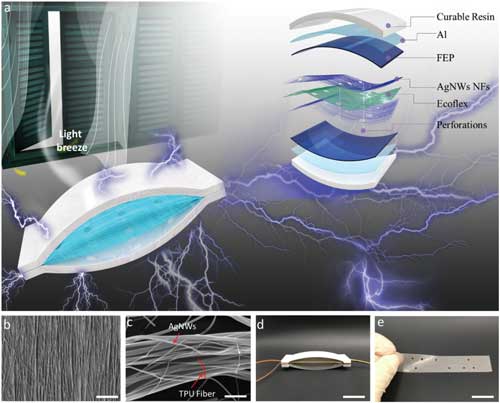| Aug 18, 2020 | |
Stretchable nanogenerators harvest energy from gentle wind breezes(Nanowerk News) The term 'wind energy'automatically conjures up images of massive wind turbines. Megawatts of power can be generated by a single wind turbine as long as the wind speed exceeds 3 meters per second in order to generate power, as limited by the physics of the electromagnetic generator. |
|
| However, most of the wind available on land is low-speed airflows, which is below the turbines' threshold speed. While these light breezes would be an effective micro energy source for small portable electronic devices, there currently is no efficient way of harvesting them. | |
| The recent invention of the triboelectric nanogenerator (TENG) has offered an unprecedented approach for efficiently converting environmental agitations into high electric outputs, especially for energy resources within low mechanical frequency, such as wind, rain drop, and water wave. | |
| Reporting their findings in Advanced Energy Materials ("Energy Harvesting from Breeze Wind (0.7–6 m s-1) Using Ultra-Stretchable Triboelectric Nanogenerator"), researcher demonstrate that a gentle wind-driven TENG (GW-TENG) can efficiently harvest energy from ultralowspeed wind/airflow of 0.7–6 m meters per second. | |
| This is equivalent to gentle wind induced by the fan of a working laptop, turning pages of a book and the side-road air flow created by a slowly passing car. | |
| Different from previously reported generators for gentle wind energy harvesting, the GW-TENG utilizes an ultra-stretchable, perforated film electrode that resembles a stirred rubber band when driven by gentle flow, to acquire an effective output from multiplied-frequency vibration. | |
| This energy harvester achieves an average power density of 20 mW m-3 with inlet wind speed of 0.7 m s-1, reaching an average energy conversion efficiency of 7.8% at wind speed of 2.5 m s-1. | |
 |
|
| Structure design of the GW-TENG. a) Schematic diagram of GW-TENG for light breeze energy harvesting. Insets: Partially enlarged diagram of AgNW NFs. b) SEM image of unidirectional TPU NFs. Scale bar: 50 µm. c) Micromorphology of the AgNW NFs, where TPU NF is wrapped by longdistance ordered AgNWs cluster. Scale bar: 600 nm. d) Photograph of the GW-TENG. Scale bar: 3 cm. e) Photograph of the ultra-stretchable AgNW NFs film electrode. Scale bar: 22 mm. (Reprinted with permission by Wiley-VCH Verlag) (click on image to enlarge) | |
| As illustrated in the figure above, the structure of GW-TENG can be divided into three parts: arch-shaped frameworks to increase triboelectric area between the elastic electrode and FEP layer; negative tribo-layer; and ultrastretchable film electrode sandwiched in them (inset in Figure a). | |
| The arched components are made by 3D printing with UV curable resin. Fluorinated ethylene propylene (FEP) is chosen as dielectric material of GW-TENG, whose surface has been treated by plasma etching for introducing nanostructures to enhance the tribo charge density. | |
| The unidirectional thermoplastic polyurethanes (TPU) spinning nanofibers (NFs) modified by ultra-long silver nanowires (AgNWs) has been compounded on surfaces of the ultra-thin Ecoflex substrate, functioning as the positive electrode tribo-layer. | |
| There are two aspects to how this GW-TENG for breeze energy harvesting works: Wind flow deforms the elastic electrode, and this electrode deformation generates electric output. When the middle film electrode deforms and vibrates in the airflow, the alternating output can be induced in the external circuit, ascribed to continuous contact-electrification and electrostatic-induction between the elastic electrode and FEP dielectric layer. | |
| To utilize the generated electricity from GW-TENG more effectively, the researchers also developed a self-charging power package based on a modified power management circuit. | |
| "Our study establishes a novel approach for efficiently scavenging commonly neglected low-speed breeze, and may function as a feasible supplementary strategy for current employed wind turbines and micro energy structure," the team concludes their work. |
 By
Michael
Berger
– Michael is author of three books by the Royal Society of Chemistry:
Nano-Society: Pushing the Boundaries of Technology,
Nanotechnology: The Future is Tiny, and
Nanoengineering: The Skills and Tools Making Technology Invisible
Copyright ©
Nanowerk LLC
By
Michael
Berger
– Michael is author of three books by the Royal Society of Chemistry:
Nano-Society: Pushing the Boundaries of Technology,
Nanotechnology: The Future is Tiny, and
Nanoengineering: The Skills and Tools Making Technology Invisible
Copyright ©
Nanowerk LLC
|
|
|
Subscribe to a free copy of one of our daily Nanowerk Newsletter Email Digests with a compilation of all of the day's news. |
